Posted by Steve Price on 09-26-2002 09:00 AM:
The nuts and bolts?
Hi Fred,
Many of our readers may be unfamiliar with how these are
made and used. Would you (or someone else) address those topics? And how do you
display things with such odd dimensions?
Regards,
Steve
Price
Posted by R. John Howe on 09-26-2002 08:29 PM:
Steve -
Is your question how does one display tent bands?
I'd think distance is important.
One would optimally want to
display them so that one could look at them closely. I once saw a display of a
collection of walking canes positioned with the tops at eye-level along the
wall of a longish hall. If the light is good, perhaps something similar might
be a natural for tent band display.
I've also wondered how best to
photograph them.
Regards,
R. John Howe
Posted by
Steve Price on 09-27-2002 08:45 AM:
Hi John,
Yes, one of my questions was about how to display tent
bands. Your suggestion is an interesting one, and I'm curious to know how Fred
(who actually deals with the problem) does his. I'd guess that the bands are
mostly rolled up with the most interesting segments exposed to view.
And
since the Salon will be archived for future reference, I also asked if someone
would post some information on the technical aspects of the weaving and on how
the items were used by the people who used them.
Regards,
Steve
Price
Posted by Fred_Mushkat on 09-29-2002 06:40 AM:
Hi Steve,
The subject of the structure is a lengthy one; perhaps
readers can start with my article in HALI 84. I am in the process of writing a
book on bands, and the chapter on structure is no doubt the hardest to put into
simple language.
The problem of displaying objects that are as narrow as
less than an inch, and as long as 40 feet may be the single most important
factor in the lack of any prominent collections prior to the 1980's. Generally,
I display bands in one of two ways. The first method involves hanging a rod,
and looping the band around it multiple times, as in the first image. The
second method is more involved: I use a 4' x 6' foam panel that doesn't off gas
and harm the textile. I cover it with washed, undyed linen. The band is mounted
using entomological mounting pins, as in the image showing two yuncu bands.
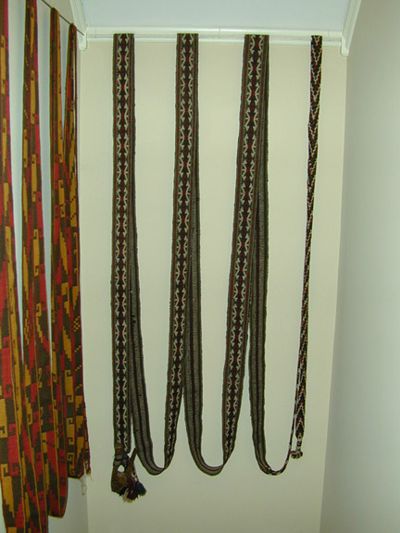
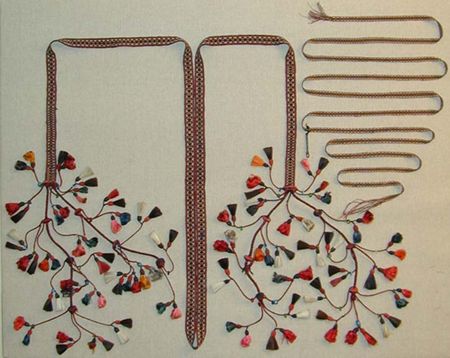
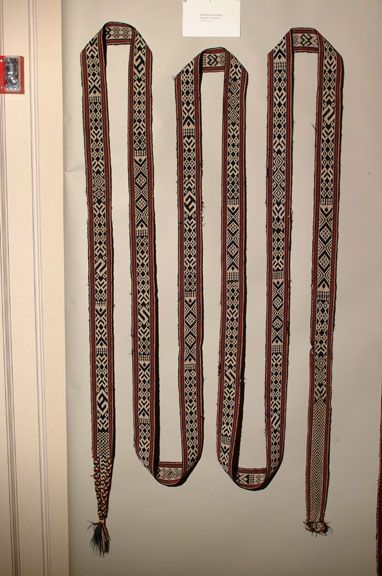
Regrettably, I do not display any
of my Iranian bands, since these are the bands I take to rug societies and loan
out to exhibitions. Additionally, for reasons I do not understand, my wife is
opposed to filling all wall space with panels displaying bands, khorjin and
rugs, using the lame excuse that she doesn't want to turn the house into a rug
museum. Go figure.
I have attached two photos from the ACOR 6 exhibit,
showing ways in which these bands can be displayed.
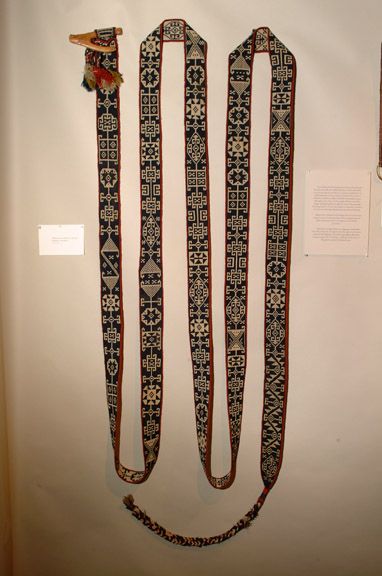
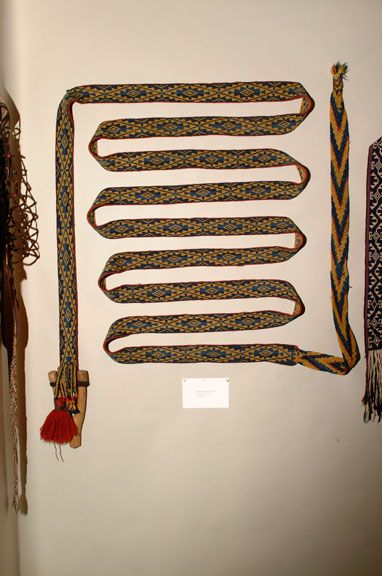
Regards,
Fred Mushkat
Posted by Steve
Price on 09-29-2002 08:25 AM:
Hi Fred,
Thanks for posting the images. Not only do they show
some ways to display these items, they also show the full lengths of the
pieces, which may surprise some readers. The third and fourth in your post show
a much greater range of motifs than most of the bands seen in the (very sparse)
marketplace.
The third one is somewhat reminiscent of Turkmen pile
decorated tentbands. The layout is very similar; a series of panels with brief
separators between them. Is this common to bands from a particular tribal
group, or is it just one of many variations in Persian
bands?
Regards,
Steve Price
Posted by Stephen Louw on
09-29-2002 04:07 PM:
Dear Fred
I think Steve's suggestion that we discuss the construction
and use of bands in more detail here is a good one. Perhaps, if you are to take
this up, you might include a discussion of (Indian) split-ply camel
girth's.
Thanks
Stephen Louw
Posted by Fred Mushkat on
09-29-2002 08:40 PM:
Hi Steve,
The band in the 3rd photo posted in this thread is a
Bakhtiyari band. There are no true separators in the field, but in a layout
common to the Bakhtiyari, there tends to be a bit of a repeat in the ways the
motifs are arranged. I have also seen this effect in Uzbek and Turkmen bands. I
accept the premise that images on bands from all Near Eastern groups have
iconography that is the oldest of their repertoire; it is not surprising that
there are similarities between groups that have had no contact for centuries.
As for structure, all of the bands under discussion are warp-faced
bands in one of five different structures: one-weft double cloth, warp-faced
alternating float weave, warp-faced reciprocal warp weave, warp-faced plain
weave with warp substitution, and warp twining. Due to a general lack of
consensus regarding nomenclature, these terms do not always appear in texts in
this exact fashion. Marla Mallet's text on woven structure uses different
terminology to describe some of the different structures.
In all of
these structures, the pattern is created with the warp threads; the wefts are
hidden. This allows the band to have great tensile strength along the length of
the bands, which gave bands the utilitarian advantage of holding loads on
animals, and holding tents together.
In order to make a pattern, the
warp threads move back and forth from the front of the band to the back,
interchanging positions with a warp of a different color. Along any length of
band, there are only two colors interchanging with one another. The limitations
of design elements are further limited by the fact that large vertical areas of
the same color weaken the fabric, making it more likely to break at that point.
Consequently, the warps must interchange frequently with one another. Given the
restrictive nature of these weavings, it is remarkable that such a wide and
creative repertoire exists.
Color is added by using different warp
colors along the width of the band, and by integrating bits of cloth, wool,
shells, beads, and buttons into the band as it is woven on the ground loom.
Although this is a very superficial overview of the structure of bands,
hopefully this will provide some understanding. As for ply-splitting, I regret
that I am not familiar enough with that structure, as it is not used in any of
the Iranian bands I have ever seen. There is an intruiging article in a recent
HALI. Perhaps those who want to learn more about this structure should look at
Peter Collingwood's website.
Regards,
Fred Mushkat
Posted by Steve Price on 09-30-2002 09:40 AM:
Hi Fred,
In referring to the layout of bands like your third one
- the Bakhtiari shown again here:

I
didn't mean that I thought the separators between segments were physical
objects, just that they visually divide one segment from the next. In this
respect they resemble Turkmen pile decorated tentbands, which also consist of
fairly long segments separated by relatively short regions of simple
design.
Regards,
Steve Price
Posted by Fred Mushkat
on 09-30-2002 09:19 PM:
Hi Steve,
That's what I meant too. The arrangement of icons
creats the visual appearance of separation.
Regards,
Fred
Mushkat
Posted by Kenneth Thompson on 10-01-2002 03:17 PM:
Attribution indicators
Dear Fred
Fascinating Salon. You are amazingly knowlegeable about
these pieces. Since there is not--as far as I know--a great deal written on the
structure and attribution of bands, what criteria do you use to distinguish
between tribal or regional sources of Persian and Turkish bands? For example,
how do you differentiate between a black and white Bakhtiari (non-soumak)
packing band and a black and white Qashgai band? Have you drawn up a list of
indicators?
Many thanks. Best regards, Ken
Posted by Fred
Mushkat on 10-01-2002 09:55 PM:
Hi Kenneth,
I apologize for referring again to my article in HALI
84, but there is a short list of indicators at the end of the article.
Structure, color, materials, and design elements all play a role in
identification. It is very helpful to handle and inspect different bands in
order to develop a feel for attribution.
For example, it is relatively
easy to distinguish between Bakhtiyari and Qashqa'i bands, even though the
field colors are usually both dark blue on a white or ivory ground. Bakhtiyari
bands are woven with warp-faced reciprocal warp weave, which creates a clear
image on the obverse, and a less well defined image on the reverse. Qashqa'i
bands, with rare exceptions, are made with warp-faced one-weft double cloth,
which makes a clearer reverse side. Additionally, as a general rule, Bakhtiyari
bands have a serrated border, whereas Qashqa'i bands have alternating 's' or
'z' shapes, usually in green and orange.
As for differentiating these
bands from Anatolian examples, it is considerally more difficult. There are
Anatolian examples which resemble Qashqa'i and Bakhtiyari bands, but have
angora wool, and a distinctly different set of design elements.
The
best way to learn about these is to see as many as possible, which is quite
difficult, since many dealers have never handled an old band. It is rare for
any but a handful of dealers to offer me a band with the proper attribution. I
recently purchased 4 bands, 3 Bakhtiyari and a Shahsevan, all mislabeled as
Qashqa'i. I have had some of the leading experts in tribal rugs mislabel these
rarities, which is understandable, given the lack of available comparison
material.
Incidentally, although it is difficult to prove, I do not
believe that these bands were woven by settled nomads or city dwellers; the
need to make these bands seems to have been a part of the nomadic lifestyle,
which disappeared with the cessation of migratory
life.
Regards,
Fred Mushkat
Posted by Kenneth
Thompson on 10-02-2002 02:53 PM:
Thanks for information
Dear Fred,
Thank you for such a detailed explanation. It helps a
great deal. I will go back over those few bands that I have and examine them
more closely. I have also faxed a request to Hali for a copy of Hali 84, since
it predates the time when I was ready to spring for a subscription.
I
wasn't aware of these bands being considered urban or even village products.
While a silver-tongued expert can always make a case for or against anything,
to me it doesn't make sense. I have always thought of them as "dual-use" tribal
items, serving a utilitarian purpose as a pack band or yurt tensioning band and
as a statement of tribe, status, and perhaps also for warding off the evil eye
during migrations. The only urban exception I can think of would be traditional
uses for gers in Mongolian cities. I suppose it is possible that bands were
woven in villages to be cut and joined into floor coverings offered for sale,
but I think one would need more information before discounting a primarily
tribal origin and function.
A note on displaying bands: I have been able
to get my Minister of the Interior to allow me to hang shorter ones vertically
in the narrow spaces between windows and to put up a fragment of a wide,
white-ground turkmen band as a small frieze in the family room. I am also
permitted a large, fabric-covered display board where I can pin up pieces for a
while, but there is always pressure to rotate them. My wife tells me it is for
my own good, since a resistance to change is a sure sign of impending male
senility. And I don't want to prove her right.
Thanks again.
Best
regards,
Ken
Posted by Vincent_Keers on 10-03-2002 06:48
AM:
Dear Fred,
For 3 years, I got a band for free. It was messured by
arms lenght 40x.
It was cut of because it was machine made.
It's ugly, it
has the colors I didn't know existed.
I didn't object because I didn't want
to offend.
My point is: There seems to be a market for machine woven,
ugly bands sold per arms lenght.
And if there's a market for machine made
bands now, what are they used for?
In shops only?
Best
regards,
Vincent
Posted by R. John Howe on 10-04-2002 03:08
PM:
Two Turkish and One Turkmen Bands
Dear folks –
The first images below are of two Turkish bands
that I cut off a rather newish grain bag of the “Bergama Cuvallari”
format. I did so because I didn’t want the bag, but the bands seemed
noticeably older than it.
The first of these Turkish bands is, I think,
one of the most frequent types encountered. The weave is the same on both
sides. The dyes seem synthetic.
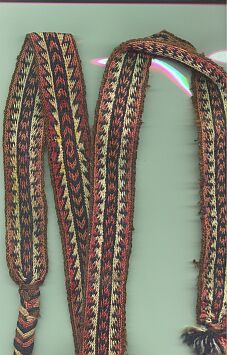
I am putting up this second band below in order to ask a
question.
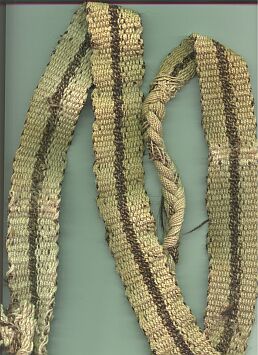
Some bands have either very simple designs, as
this one does,or none at all. (I own a completely plain one currently in use to
hold a cordless phone base in the proper position on my kitchen wall.) My
question is this: a great deal of macrame, including plaits of various sorts,
is done in one color and appreciated strictly in terms of texture alone. It
appears that the band collectors do not collect entirely plain bands, being
attracted only to those with colored patterns on them. I wonder a little why
this is so. Yes, the colored ones are prettier, but one could make a case that
the plain ones have their own attractions and are likely even more utilitarian
if that feature is seen to be important.
The third band below is a Yomud
tent band about 10 inches wide. I have two fragments totaling about 25 feet.
The first image is of the best decorated end.
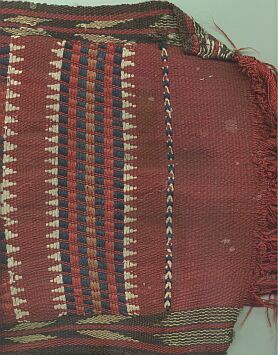
The image below is a detail of one front section. This
diamond design is the most common of the Yomut tent bands of this wider
type.
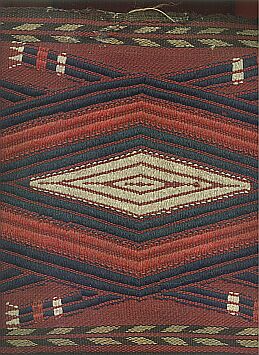
The image below is of the back. Note that
there are floats on the band’s edges but only there.
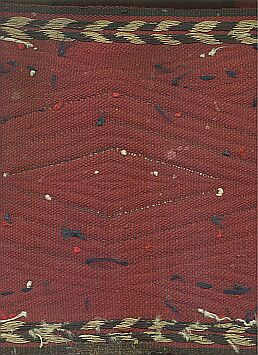
Fred may be willing to comment on the structures in these
three pieces.
Regards,
R. John Howe
Posted by
Fred_Mushkat on 10-07-2002 08:59 AM:
Hi John,
Much like many of the comments in the virtual show and
tell going on now about synthetic dyes, I suspect the collecting of plain bands
is one of personal taste. No doubt, a band with great colors and iconography is
usually preferred to a plain band. Some of the bands in my collection are quite
simple in design, yet I bought them because I wanted to have examples of bands
that were more utilitarian than decorative. Below is a detail of a 40 foot long
Transcaucasian band with simple stripes. It was most likely used as a pack
animal band.
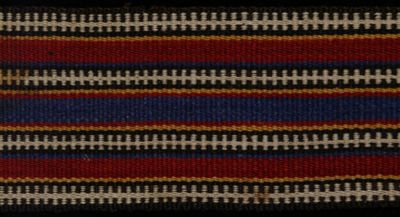
I am currently reading a book on Ottoman tents, and find
it curious that all the bands discussed are very plain, with virtually no
decoration. Below is a photo of some bands from one of these tents; the photo
is somewhat pink, but the bands are a plain ivory color.
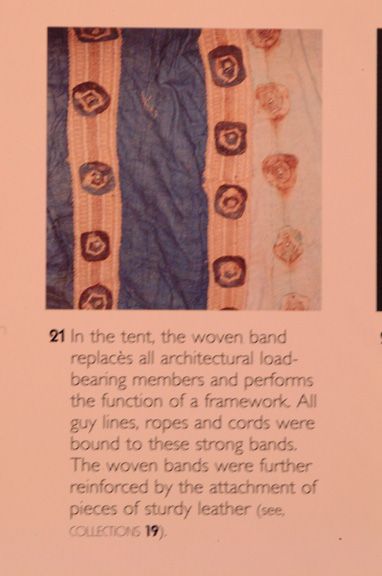
As for the structure of the bands in your comments, the
first band with the serrated borders is structurally similar to Bakhtiyari
bands, with warp twining on the borders, and a type of warp-faced reciprocal
warp weave. Below is a closeup of a similar band from my collection, which was
used for carrying children on the mother's back.
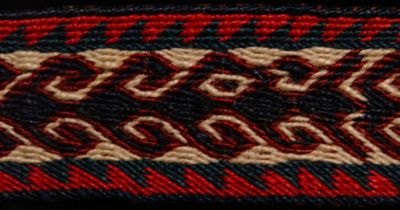
The plain brown band with the dark brown center stripe
appears to be a very simple structure, namely warp faced plain weave. This
structure allows the band to carry weight along the long axis of the textile.
Yomut bands like the one you have shown are made on a ground of warp-faced
plain weave, with weft float brocading creating the designs. A discussion of
this structure appeared in volume 18 of the Textile Museum Journal, written by
John Wertime in 1979. Please see the attached caption.
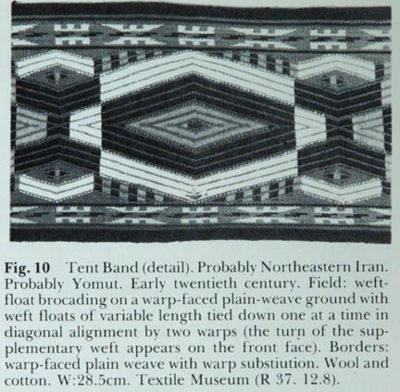
Regards,
Fred Mushkat
Posted by Chuck
Wagner on 10-12-2002 02:37 PM:
Greetings all,
I'm posting some images of bands I've found which
were purchased primarily because of the colors used in them and, to a lesser
extent, that they are unusual within the marketplace here in Saudi Arabia. At
this point I have no reason to believe that they are particularly
old.
If anyone has comments or observations to make, feel free. If there
is any interest, I have detail shots of the reverse sides as
well.
The first is a Qashqai malband with very attractive finish
work:

Next, an Uzbek yurt band. These show up here
infrequently:
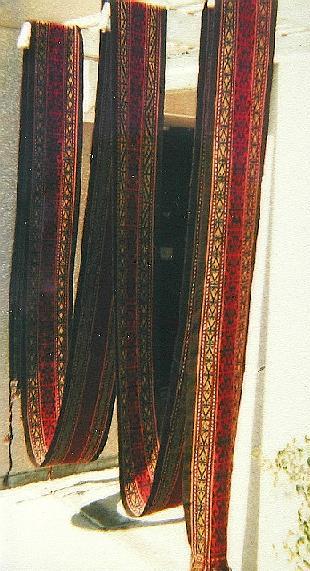
Last, two bands of unknown origin,
although the yarns resemble those in the Uzbek band. They're each about 4 cm
wide:
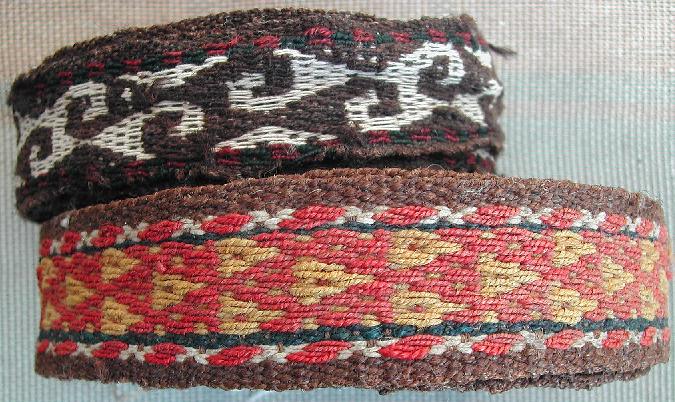
And last, a question. Does anyone have any idea how long
it takes to weave a band that is, say, 6 inches wide and 30 feet long ? Are we
talking days or weeks ?
Regards,
Chuck
__________________
Chuck Wagner
Posted by Fred Mushkat on 10-13-2002 06:43 AM:
Hi Chuck,
It's always nice to see a collector of bands.
The first band has serrated borders, and the end of the band that I can
see in the photo is a checkerboard pattern. The colors and end finishes are
typical of Bakhtiyari bands, which are much less common in the marketplace than
the Qashqa'i.
It is difficult to make out much detail on the wide Uzbek
band, but the two bands below it are also commonly attributed to the Uzbek.
As for how much time it takes to weave a band, I have no direct field
knowledge. Given the complexity of the structure, I doubt that the task could
be completed in days for a 20 to 40 foot long band; I would guess that weeks is
more likely.
Regards,
Fred Mushkat
Posted by Chuck
Wagner on 10-13-2002 11:24 AM:
Yay Fred
Hi Fred,
As it happens, the reason the first band was purchased
was because I thought the colors were pretty unusual for a Qashqai piece, even
though that's how the dealer had it tagged. I haven't seen that pale green in
any Bakhtiyari goods I've laid hands on. Is it in common use in Bakhtiyari
utility goods ?
Thanx
Chuck
__________________
Chuck Wagner
Posted by Fred Mushkat on 10-14-2002 01:29 AM:
Hi Chuck,
These bands are so rare that there aren't a lot of
examples out there. Green does occur in the serrated border, but I have not
seen another with what appears in your photo as a light yellow green. It looks
like a typical Bakhtiyari band otherwise.
Regards,
Fred
Mushkat
Posted by Chuck Wagner on 10-14-2002 01:09 PM:
Hi Fred,
For documentary purposes, I've included some closeups
for anyone who's interested. The first is the malband; the colors are quite
clear in this shot:
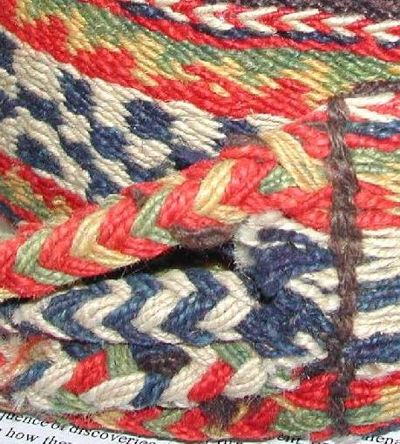
The others are paired front and
back closeups of the Uzbek bands:
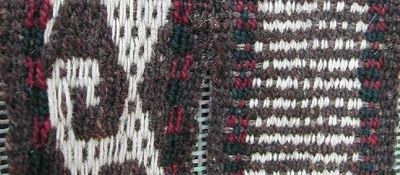
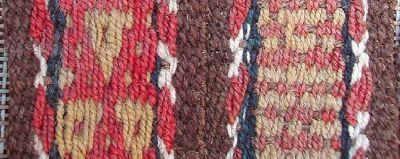
Thanx again Fred, for a very novel Salon
topic.
Regards,
Chuck
__________________
Chuck Wagner
Posted by R. John Howe on 10-15-2002 07:25 AM:
Dear folks –
While we’re putting up various bands, here
are two images that relate to our discussion in this thread.
The first
is a short Uzbek band.
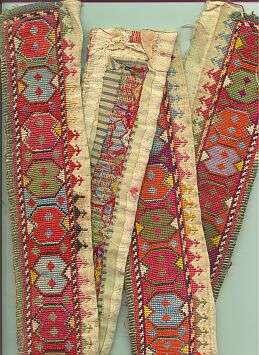
One sees these rather frequently
now on the market. Note that the color palette, like (but different from) that
of Lakai pieces, is also quite different from that of most Turkmen weaving.
Such bands are often found now in lengths that are very short. This one is
about 4 feet long and has no ending “tie” area, raising the question
for me of how they were used.
The second image is one illustrating the
point I made above about how macrame often depends on texture alone for its
effects.
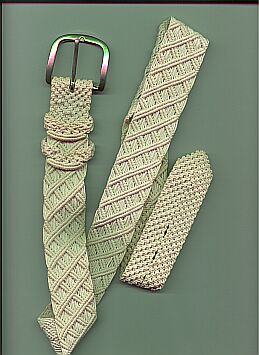
This is a macrame belt that I made
for my wife sometime in the 70s. It is made entirely with double half hitches
and alternating square knots. The knots used in macrame work have advantages
for “texture only” effects over most of “weaves” that
weavers use, since the texturing provided by the knots is more distinctive.
Macrame knotters choose cord carefully for such pieces that provides good
“knot definition.” This belt is done in a number 10 cotton seine
line.
Regards,
R. John Howe
Posted by Marla Mallett
on 10-15-2002 06:08 PM:
Here's my two cents worth on how long it takes to weave some of these
bands, having had experience will all of the techniques:
Most of the
warp-twined bands (card-woven) are quick. One can easily do two or three meters
of length in an hour's time. The Bakhtiari warp-twined bands with fancy
patterning would not be so fast.
The double-woven examples, such as the
Qashqai malbands require more time, as one must pick the pattern by hand for
every second weft. Those, depending upon their coarseness, may require a hour
or more for one meter. Of course one's skill and familiarity with the pattern
makes a big difference.
Marla
Posted by Chuck Wagner on
10-17-2002 04:18 PM:
Band Practice
Hi Fred,
Since I now know two things about a few of my
bands:
1) The dealer had at least one attributed
incorrectly
and
2) I haven't a clue how to attribute bands other
than guessing about the colors,
I'll now post some images of the
remaining two and go fishing for a little insight from someone
else.
Band one (lots of south-Persian-looking colored tufts
attached):
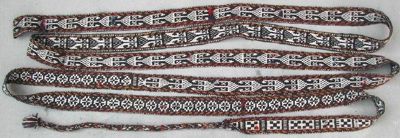
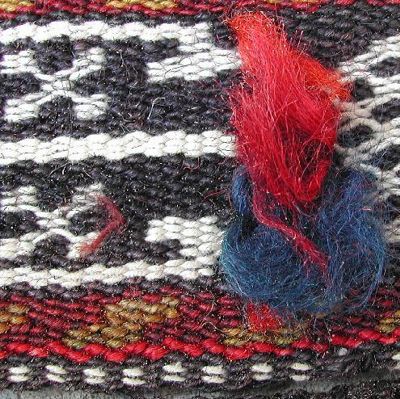
Band two:
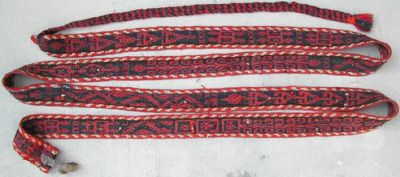

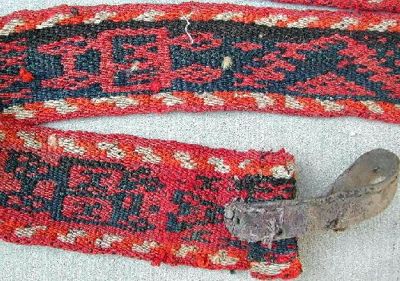
And, John.. note that Band two has
a leather strap stitched to one end and it looks like a buckle could have been
attached to the other end. Does the Uzbek band you show look like it might have
been set up for use with a buckle ? I can't see the ends very well in the
image. Guess two: a strap for an over the shoulder utility
article.
Regards,
Chuck
__________________
Chuck Wagner
Posted by Fred Mushkat on 10-19-2002 06:21 AM:
Hi Chuck,
Both bands are Qashqa'i; the second looks younger than
the first. The leather strap is used by the Qashqa'i to attach the buckle.
There are people who collect buckles for their sculptural qualities, and it is
not uncommon to find a band with the missing buckle. A dealer in London once
suggested to me that the buckles were commonly removed and thrown away in order
to reduce the weight of the textile at the time it was
exported.
Regards,
Fred Mushkat


























